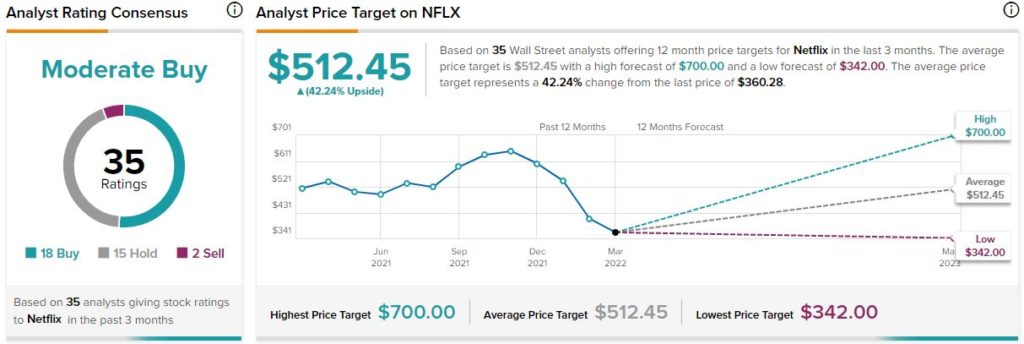Shares of video-streaming giant Netflix (NFLX) find themselves not too far off their 52-week lows of around $340 per share. Indeed, Netflix’s quarterly result was a disaster, but many wise folks, including billionaire activist investor Bill Ackman, were big buyers of the dip. Netflix founder and CEO Reed Hastings also added to his stake following one of the worst post-quarter plunges in recent memory.
Undoubtedly, the video-streaming space isn’t as exciting as it used to be. It’s no longer on the cutting edge of innovation, and for Netflix, that could mean the days of massive gains could be drawing to a close. In such a scenario, the valuation reset would prove more than warranted. I am neutral on NFLX stock.
Netflix Starting to Feel the Heat from Video-Streaming Rivals
Media empires such as Disney (DIS) and ViacomCBS (VIAC) were forced to pivot into the new realm. Meanwhile, disruptive tech companies, most notably Apple (AMZN) and Amazon (AMZN), set their sights on the market with a slow and steady build-up to bolster their service businesses.
Even ailing media-player maker Roku (ROKU) has been getting in on the streaming action. With so much in the way of competition, video streaming was likely to mature and economic profits were likely to come with much higher expenditures, perhaps much higher for smaller firms like Roku to stomach.
Indeed, video streaming is no longer offers the same return on invested capital as it used to. It’s arguable that given how mature the market has become that it’s a risky time to get in.
Just How Wide Is Netflix’s Moat?
Undoubtedly, investors should have seen Netflix’s epic fall coming. The market has been getting crowded for years now. While smash hit Squid Game got investors excited, there was no denying that future growth was likely to get lumpier and perhaps more expensive than it had ever been in the past. That’s what rising competition can do to a firm that can’t further differentiate itself.
While a case could be made that Netflix has the algorithms and talent to retain the width of its moat, one can’t help but notice that industry trends are no friend of an incumbent leader like Netflix. In short, the video-streaming lead seems to be for Netflix to lose.
While I don’t doubt the capabilities of Reed Hastings or the investment wits of Bill Ackman, I find it hard to get behind the company at 32 times trailing earnings. That’s far too expensive for a company that could face a considerable (and sustained) deceleration to its growth rate over the coming years.
Inflation Pressures Consumer Wallets
Consumers are finding themselves using more and more streaming services. With high levels of inflation weighing on their personal budgets, we’re about to find out which services will have the most pricing power.
Netflix has a deep library of content and intriguing new releases steadily flowing out of the pipeline. Even with recent price increases, the value proposition is still high for some consumers who will gladly pay more for their Netflix subscriptions.
As an added bonus, Netflix is serious about growing its lineup of mobile games. That said, I do not view the minimal mobile game offering as a sufficient “sweetener” for most to stomach the hit of recent price increases.
Netflix has not been met with subscription cancellations en masse during its last price hike. Does that mean Netflix has immense pricing power? Perhaps, but there are notable differences that could see price hikes hurt sales growth substantially this time around.
First, the average consumer could be poised to allocate a larger portion of their budget towards out-of-home entertainment now that the economy is reopening, with fewer and fewer restrictions. After years of staying home to watch Netflix, many may be inclined to pause their Netflix subscriptions in response to recent price increases.
Second, the competition is getting difficult to ignore. Netflix has remained rather consistent, but Apple TV+, Disney+, and Amazon Prime Video have become much stronger since their respective debuts. Given this, Netflix’s challengers seem worthier of price increases than Netflix.
As the industry matures further, I think Netflix and its top three rivals will approach some sort of equilibrium. In five years, we may very well refer to the top streamers as “The Big Four” as opposed to “Netflix and rivals.”
Wall Street’s Take
Turning to Wall Street, NFLX stock comes in as a Moderate Buy. Out of 35 analyst ratings, there are 18 Buys, 15 Holds, and two Sell recommendations.
The average Netflix price target is $512.45, implying an upside potential of 42.2%. Analyst price targets range from a low of $342.00 per share to a high of $700.00 per share.

The Bottom Line on Netflix Stock
What is the only way for Netflix to stay ahead as rivals move in? Raising the bar on content spend. Whether such spending pays off is less clear.
The way I see it, more players are spending more money to get a larger slice of a streaming pie that’s unlikely to get much larger. As inflation takes a toll on consumer wallets while the number of competing options grows, we’ll find out just how much pricing power Netflix really has.
Download the TipRanks mobile app now
To find good ideas for stocks trading at attractive valuations, visit TipRanks’ Best Stocks to Buy, a newly launched tool that unites all of TipRanks’ equity insights.
Read full Disclaimer & Disclosure









